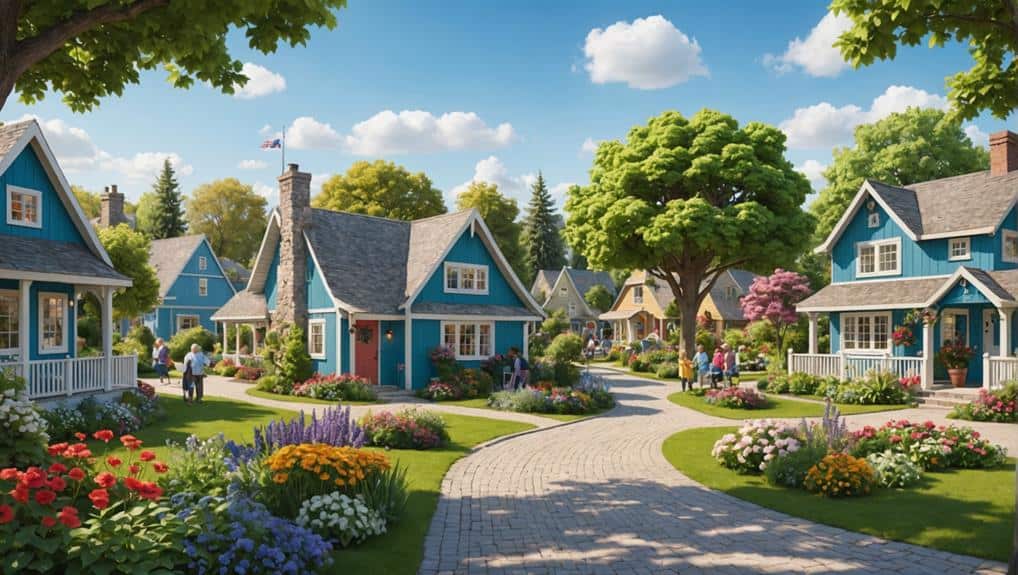Dementia villages are innovative care models designed for individuals with severe dementia or Alzheimer's. They create safe yet independent living environments. Residents engage in daily activities, promoting social interaction and emotional well-being. These villages offer personalized care, with a high carer-to-resident ratio that guarantees attention and support. They're designed with familiar decor to reduce confusion, helping residents feel more at home. Admission can be expensive, often exceeding $8,000 monthly, but financial assistance may be available. These communities set new standards for dementia care, enhancing quality of life, and if you want to explore further details, there's more to uncover.
Definition of Dementia Villages
In these communities, residents enjoy the freedom to engage in daily activities, which fosters community engagement and interaction. They can participate in social events or simply stroll through the village, all while being closely monitored by on-site carers. This balance guarantees safety while encouraging independence, which is essential for their overall well-being.
The concept of dementia villages emphasizes person-centered care. For instance, Hogeweyk in the Netherlands is a well-known model featuring unique apartments tailored to each resident's lifestyle and preferences. This approach allows individuals to live in an environment that respects their personal history and choices.
Admission to dementia villages typically requires residents to have severe dementia or Alzheimer's, assuring that the structured environment meets their specific needs. While the care can be costly, with monthly expenses nearing $8,000, various financial assistance options are available, including government subsidies and family contributions based on income. These communities represent a significant step forward in providing compassionate, effective care for individuals living with dementia.
Key Features and Innovations
Within these villages, you'll find apartments tailored to reduce confusion for residents. Each unit is decorated with familiar colors and personal touches that reflect the residents' lifestyles, guaranteeing a comforting atmosphere. Typically, there are 23 unique apartments that accommodate 6 to 8 residents each, fostering a sense of belonging. The emphasis on personalized support tailored to individual routines in these environments aligns with the best practices seen in dementia care at home, ensuring that residents feel both safe and understood.
Personalized care is a cornerstone of these models. Care matching services, like Lottie, help families find suitable dementia homes that align with individual needs and budgets. In dementia villages, you'll often see a high carer-to-resident ratio, such as 2:1 at Hogeweyk. This guarantees residents receive individualized attention, allowing caregivers to build strong relationships with them.
Moreover, dementia villages prioritize social engagement through activity clubs and community gardens. These features encourage residents to connect with one another, enhancing their emotional well-being. By combining thoughtful community design with personalized care, dementia villages create an enriching environment that greatly improves the quality of life for those living with dementia.
Notable Dementia Villages
- Hogeweyk Insights: Opened in 2009, Hogeweyk accommodates 152 residents in a village-like setting designed to reflect normal life. With a carer-to-resident ratio of 2:1, residents receive personalized attention and care tailored to their needs. The apartments feature familiar decor, which helps reduce confusion and enhances comfort.
- Hudson Hills: Completed in 2018, Hudson Hills offers 72 dementia units focused on promoting a vibrant social life. Residents engage in community activities that encourage participation, helping to foster connections and a sense of belonging.
- Cuijkse Cantheelen: This village, also in the Netherlands, consists of 205 dementia units spread across 97 care homes and social hubs. Since its opening in 2012, it's created a supportive residential environment, emphasizing social integration.
These villages demonstrate the profound impact that thoughtful design and community involvement can have on individuals living with dementia. By prioritizing normalcy and social engagement, they set a benchmark for future dementia care models, proving that a fulfilling life is possible even in the face of cognitive challenges.
Admission Criteria and Costs
When it comes to costs, living in a dementia village can be significant. Monthly care expenses often exceed $8,000, which can be a considerable financial burden. However, the Dutch government offers financial assistance to help alleviate some of this stress. Families are expected to contribute based on their income, with a maximum payment set at around $3,600 per month. This arrangement guarantees that care remains affordable while maintaining high-quality services.
Residents are typically provided with private rooms, reflecting the personalized approach to care that dementia villages prioritize. This setup allows individuals to feel comfortable and secure in their environment, promoting a sense of dignity and belonging. It's essential for families considering this option to understand both the admission criteria and the associated costs, as this knowledge can help them make informed decisions about their loved ones' care.
Future of Dementia Care
- Expansion of Successful Models: Expect to see more dementia villages like Hogeweyk popping up in various regions. As the demand for specialized care grows, these models will offer safe and engaging spaces for individuals living with dementia.
- Emerging Care Matching Services: Services like Lottie are making it easier for families to find suitable dementia homes that match their loved one's needs and budget. This personalized care approach guarantees that residents receive the attention and support they require.
- Adaptive Reuse of Spaces: There's a growing trend to repurpose existing structures, such as closed malls, into dementia care settings. This not only utilizes available resources but also fosters community-friendly solutions that cater to the evolving needs of individuals with dementia.





